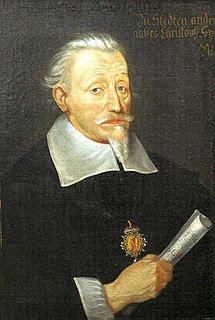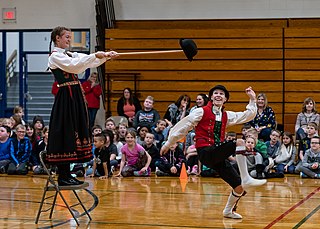Related Research Articles
In musicology, the opus number is the "work number" that is assigned to a musical composition, or to a set of compositions, to indicate the chronological order of the composer's production. Opus numbers are used to distinguish among compositions with similar titles; the word is abbreviated as "Op." for a single work, or "Opp." when referring to more than one work.

Heinrich Schütz was a German composer and organist, generally regarded as the most important German composer before Johann Sebastian Bach, as well as one of the most important composers of the 17th century. He is credited with bringing the Italian style to Germany and continuing its evolution from the Renaissance into the Early Baroque. Most of his surviving music was written for the Lutheran church, primarily for the Electoral Chapel in Dresden. He wrote what is traditionally considered to be the first German opera, Dafne, performed at Torgau in 1627, the music of which has since been lost, along with nearly all of his ceremonial and theatrical scores.

Geirr Tveitt, born Nils Tveit was a Norwegian composer and pianist. Tveitt was a central figure of the national movement in Norwegian cultural life during the 1930s.

Hugo Emil Alfvén was a Swedish composer, conductor, violinist, and painter.

Franz Xaver Wolfgang Mozart, also known as Wolfgang Amadeus Mozart, Jr., was the youngest child of six born to Wolfgang Amadeus Mozart and his wife Constanze and the younger of his parents' two surviving children. He was a composer, pianist, conductor, and teacher of the late classical period whose musical style was of an early Romanticism, heavily influenced by his father's mature style.

The Halling (hallingdansen) is a folk dance (bygdedans) traditionally performed in rural Norway, although versions of the halling can also be found in parts of Sweden. The dance is traditionally performed by young men at weddings and parties.

Opus Anglicanum or English work is fine needlework of Medieval England done for ecclesiastical or secular use on clothing, hangings or other textiles, often using gold and silver threads on rich velvet or linen grounds. Such English embroidery was in great demand across Europe, particularly from the late 12th to mid-14th centuries and was a luxury product often used for diplomatic gifts.

The composer Sergei Rachmaninoff produced a number of solo piano pieces that were either lost, unpublished, or not assigned an opus number. While often disregarded in the concert repertoire, they are nevertheless part of his oeuvre. Sixteen of these pieces are extant; all others are lost. Ten of these pieces were composed before he completed his Piano Concerto No. 1, his first opus, and the rest interspersed throughout his later life. In these casual works, he draws upon the influence of other composers, including Frédéric Chopin and Pyotr Tchaikovsky. The more substantial works, the Three Nocturnes and Four Pieces, are sets of well-thought out pieces that are his first attempts at cohesive structure among multiple pieces. Oriental Sketch and Prelude in D minor, two pieces he composed very late in his life, are short works that exemplify his style as a mature composer. Whether completed as a child or adult, these pieces cover a wide spectrum of forms while maintaining his characteristic Russian style.
The Biamonti Catalogue is a catalogue of Ludwig van Beethoven's compositions published in 1968 by the ILTE of Turin. The original name of the work is Catalogo cronologico e tematico di tutte le opere di Beethoven, comprese quelle inedite e gli abbozzi non utilizzati. Giovanni Biamonti tried to combine all pieces of the author, including all works approached in other catalogues, in a single chronological listing. All other catalogues are numbered by date of publishing. The numeration system used is "Bia" plus the number attributed to the piece in the catalogue.

The Catalogues of Beethoven compositions are all of the different ways in which the musical compositions by Ludwig van Beethoven have been organized by researchers into his music.
This article gives an overview of various catalogues of classical compositions that have come into general use.
A Hundred Hardanger Tunes is a collection of folk songs from the Hardanger region of Norway arranged for orchestra by the composer Geirr Tveitt between 1954 and 1963. Of the originally planned 100 tunes, 4 suites with a total of 60 songs are extant.
In music, Op. 111 stands for Opus number 111. Compositions that are assigned this number include:
In music, Op. 129 stands for Opus number 129. Compositions that are assigned this number include:
In music, Op. 151 stands for Opus number 151. Compositions that are assigned this number include:
References
- List of compositions by Tveitt by Opus number. at geirrtveitt.com